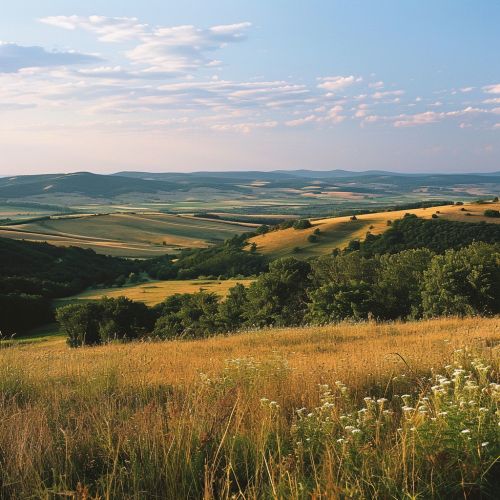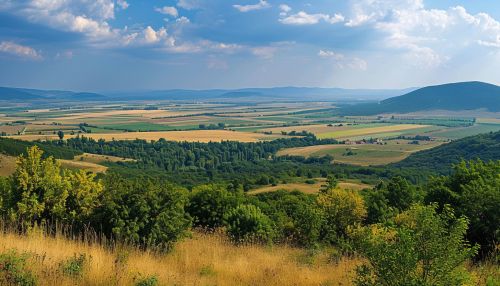Hungary
Geography
Hungary is a landlocked country in Central Europe. It is situated in the Carpathian Basin and is bordered by Slovakia to the north, Ukraine to the northeast, Austria to the northwest, Romania to the east, Serbia to the south, Croatia to the southwest, and Slovenia to the west. The country's capital and largest city is Budapest.


The Hungarian landscape is varied, with hills and low mountains to the west, and the flat Great Hungarian Plain to the east. The highest point in Hungary is Kékestető in the Mátra Mountains, at 1,014 meters above sea level. The lowest point is the Tisza River near Szeged, at 78 meters above sea level.
The country's major rivers are the Danube and Tisza. The Danube is navigable within Hungary for 418 kilometers. The Tisza River is navigable for 444 kilometers in the country. Hungary has three major lakes. Lake Balaton, the largest, is 78 kilometers long and covers an area of 592 square kilometers, making it the largest lake in Central Europe.
Climate
Hungary has a temperate seasonal climate, with generally warm summers and cold, cloudy, humid winters. The average annual temperature is 9.7 °C. Temperature extremes are about 42.9 °C on the hottest summer days and −35 °C on the coldest winter nights. Average annual rainfall is about 600 millimeters. A small, southern region of the country near Pécs enjoys a reputation for a Mediterranean climate, but in reality it is only slightly warmer than the rest of the country and still receives snow during the winter.
History
Hungary's history dates back to the ancient times when it was inhabited by Celtic tribes. The Roman Empire conquered territory west of the Danube River between 35 and 9 BC. From 9 BC to the end of the 4th century AD, Pannonia, the western part of the Carpathian Basin, was part of the Roman Empire.
The first known inhabitants of present-day Hungary were the Celts before the Roman conquest. After the fall of the Roman Empire, the Huns settled in the plains of Pannonia and established the Hun Empire, which was influential in the region for centuries.
In the 9th century, the territory was inhabited by the Slavs, who were later largely displaced by the Magyars, or Hungarians, a Finno-Ugric people who established the Hungarian state in 895. The Kingdom of Hungary was established in 1000 AD by King Stephen I, who was canonized as the first King of Hungary and is regarded as the founder of the Hungarian state.
Hungary underwent a lot of changes in the 20th century. After World War I, the Treaty of Trianon resulted in significant territorial losses for Hungary. During World War II, Hungary was a member of the Axis powers. The post-war Soviet occupation led to the establishment of a communist regime that lasted until 1989. The country transitioned to a market economy and a multi-party democracy and joined the European Union in 2004.
Politics
Hungary is a parliamentary republic with a multi-party system. The current political landscape is dominated by the conservative Fidesz, which maintains a supermajority, and includes other parties such as Jobbik, the Hungarian Socialist Party, and the Democratic Coalition.
The President of the Republic, elected by the National Assembly every five years, has a largely ceremonial role. The Prime Minister is elected by the National Assembly and serves as the head of government and exercises executive power.
Hungary has a civil law system. The judicial authority is exercised by the courts, and the highest judicial authority is the Curia. The members of the Constitutional Court are elected by the National Assembly for twelve-year terms.
Economy
Hungary has a high-income mixed economy with a very high Human Development Index and a skilled labour force. The Hungarian economy is the 57th-largest economy in the world (out of 188 countries measured by IMF) with $265.037 billion annual output.
The country is a significant exporter of machinery and equipment, pharmaceuticals, food products, and automotive products. It is also known for its wine production, particularly in the regions of Tokaj, Eger, and Villány.
Hungary has made significant progress in developing structural economic reforms, such as labor market flexibility and pension reform. While the private sector accounts for over 80% of GDP, there are state-owned enterprises (SOEs) in strategic sectors of the economy, including transport and energy.
Culture
Hungarian culture is diverse and varied. It has been influenced by its history, geography, and the cultures of the neighboring countries. The culture is rich in folk traditions, music, fine arts, literature, and gastronomy.
Hungarian music ranges from the rhapsodies of Franz Liszt and folk music to modern songs influenced by folk, jazz, and electronic music. Hungary has made many contributions to the fields of folk, popular, and classical music.
Hungarian literature has a rich heritage, with the earliest known Hungarian text, the Old Hungarian 'Laments of Mary', dating back to the 13th century. Hungary has produced several prominent literary figures, including Sándor Márai, Imre Kertész, who won the Nobel Prize in Literature in 2002, and contemporary authors such as Péter Esterházy and László Krasznahorkai.
Hungarian cuisine is a prominent feature of the culture. Hungarian food is hearty and spicy, and it features a wide variety of soups, stews, pastries, sausages, pâtés, and cheeses. The country is also known for its excellent wines, including Tokaji and Egri Bikavér.
